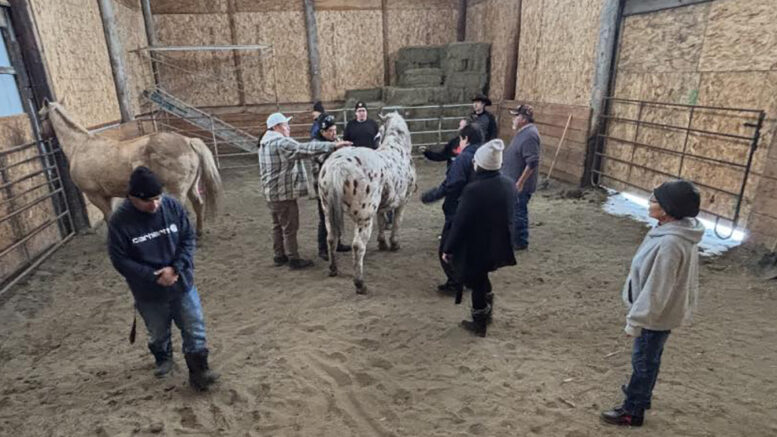(ANNews) – For more than three decades, Patrick Buffalo — also known by his Cree name Kisikaw-Pimotew, which means Day Walker — has been a quiet force in Maskwacis. He is the owner of Day Walker and Company, a teacher, an entrepreneur, and a trailblazer who refused to wait for permission to help his people. Long before the term “community wellness” existed, Buffalo was already doing the work. People call him a healer, but he refuses the title, affirming that people heal themselves.
But his story didn’t begin with healing. It began with business, ambition, and a desire to break cycles of dependency.
From Electrician to Advocate for Private Enterprise
Patrick’s career started in 1977 when he trained as an electrician. Through the 1980s, he became a strong advocate for private enterprise in First Nation communities — a stance that was revolutionary at the time.
“Private enterprise has no chance in a system where chief and council control every entry point for business. It’s almost a communist environment. Independent business can’t survive.”
Back in the 1980s, Patrick was president of the Chamber of Commerce for his nation, but it was Samson Chief and Council who led the condominium warehouses and other projects. The initiatives didn’t last long because Samson Cree Nation did not actively promote private enterprise — everything had to go through the nation. Internal lateral violence among members and the preference to support off-reserve businesses rather than their own further undermined these efforts.
Historically, the Four Nations of Maskwacis built up the surrounding small towns with their wealth and resources during the 1980s oil and gas boom, but they failed to promote and sustain private enterprises among their own members. Patrick saw first-hand how this economic imbalance hindered long-term community independence.
Despite the setbacks, Patrick refused to be defeated. He stayed independent, determined to build something that could not be taken from him.
That “something” came from the horses.
A Horse That Healed Him — And Changed His Life
In 1987, Buffalo experienced a profound awakening. But ten years later, a new chapter opened when he discovered an unexpected source of healing.
After offering tobacco, he began noticing unusual events. He crushed his hand in an accident — a pain level he rated at 10. One of his horses walked up to him. Patrick placed his injured hand on her.
The pain disappeared instantly.
Weeks later, he burned his hand badly — “a 20 out of 10,” he says. A different horse approached him. Again, when he placed his hand on the horse, the pain vanished.
These experiences reshaped his life.
Patrick’s son shared the stories online, and soon people from across the country were arriving at their home for healing.
Tatomasowin and Manaciso: Healing with Horses
Patrick developed Tatomasowin, a program called Healing with Horses, and Manaciso, another program he offers. Manaciso is a Cree word meaning empower yourself, self-respect, take care of yourself, honour yourself — a perfect description of the work.
People come not for entertainment, but for transformation.
Patrick and his son, Mason Buffalo, also created Mostosomay Village, named after an ancestor whose name means “buffalo chips” in Cree. Today, the village includes a classroom, a small arena, and dedicated spaces for healing, teaching, and working with horses.
He built everything with his own hands, using only the income he made through Day Walker and Company.
“No funding. Ever. I eat what I kill. If I earn it, I build with it.”
This independence is not only practical — it is philosophical.
The Heart vs. the Head: Healing the Right Way
When First Nation bands and schools hire Patrick, they often send the “bad kids,” the ones struggling or acting out. Too often, the process stops before it starts.
“Many staff believe they’re already healed. They think they don’t have issues. But too many people heal only in their head — intellectually. True healing must come from the heart.”
This heart-based understanding drives all his work.
Teaching the Next Generation
In the past two years, demand for Patrick’s teachings has exploded. He has now trained 67 practitioners from Vancouver Island to North Bay, Ontario — people who want to learn his methods and carry them home.
Workshops are constant. The call for healing is growing.
Reclaiming Self-Reliance Through Private Enterprise
For Buffalo, this journey isn’t just professional — it’s spiritual.
“Our people once understood our own inner strength. We were self-reliant. We didn’t rely on others. That’s what we’ve lost.”
To him, the greatest challenge today is rediscovering that independence through private enterprise, and rebuilding internal capacity so communities no longer depend on external systems.
In his own work, self-reliance is inseparable from the relationship between people, community, healing, and the lessons carried by horses.
A Trailblazer Who Didn’t Wait for Permission
Even after decades of lateral violence, sabotage, and institutional barriers, Patrick Buffalo still stands — humble, determined, and committed to healing. He created his business without funding. He built Mostosomay Village from the ground up. He trained the next generation of healers.
And he continues to challenge systems that restrict Indigenous independence.
Patrick Buffalo is more than a facilitator. He is a living example of Indigenous self-reliance — the very thing he teaches through Day Walker and Company.



Be the first to comment on "Patrick Buffalo: A Lifetime of Healing, Horses, and the Fight for Private Enterprise"